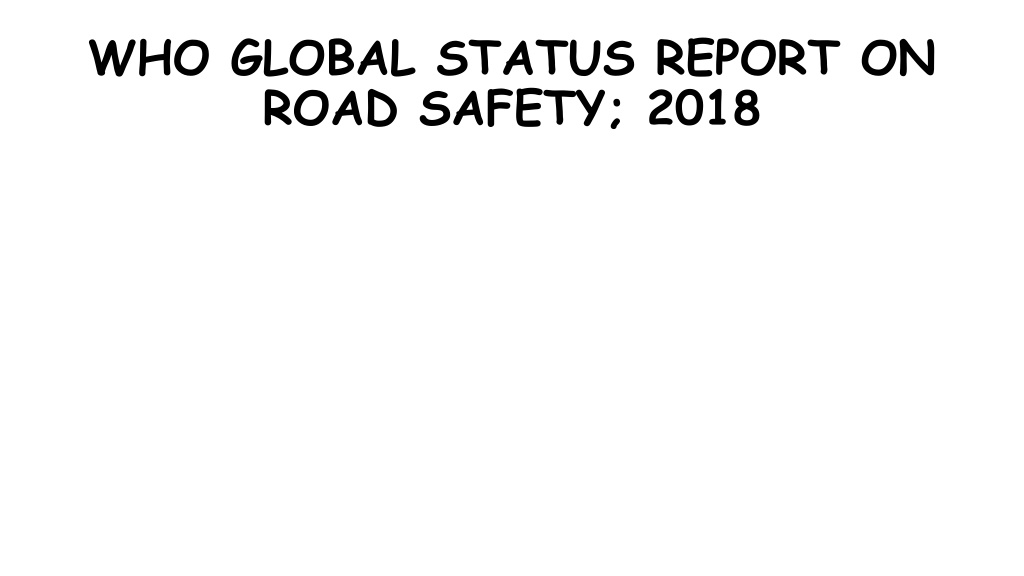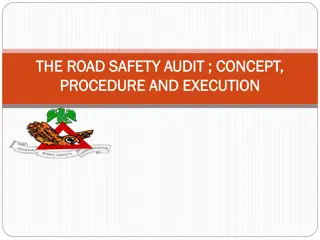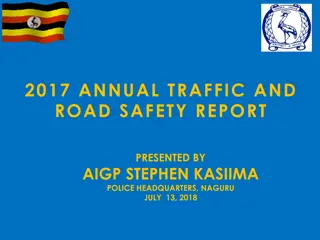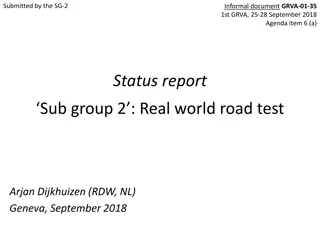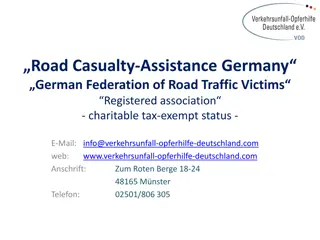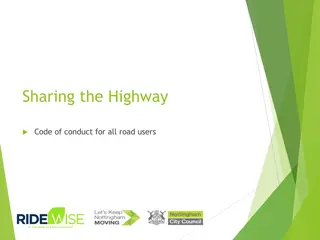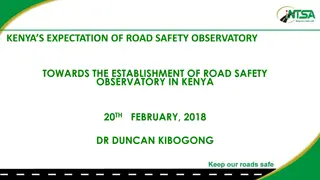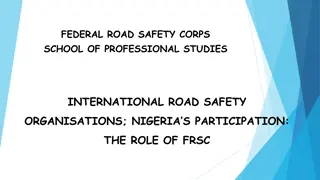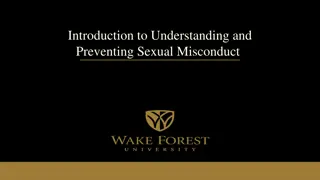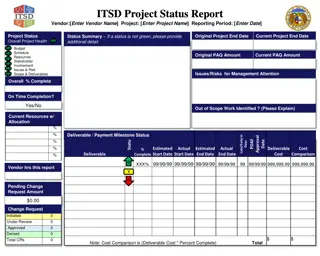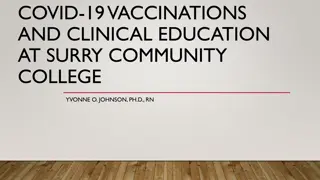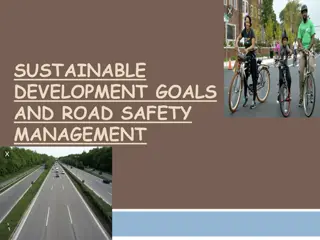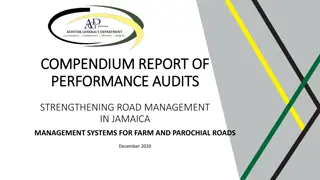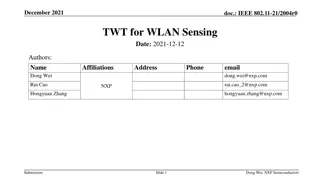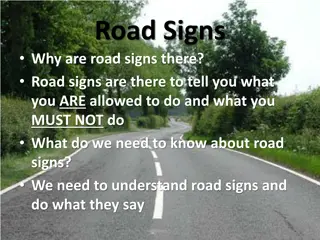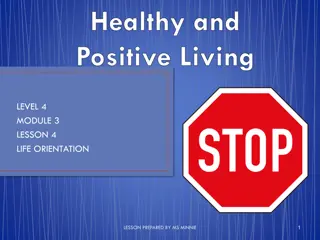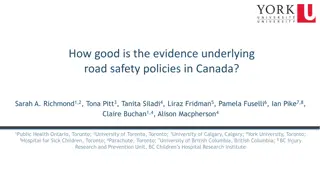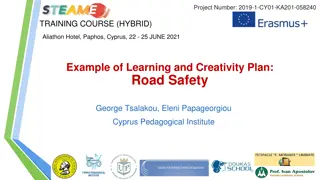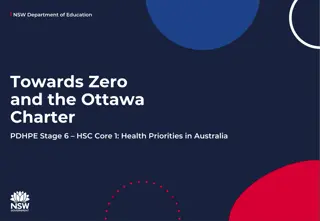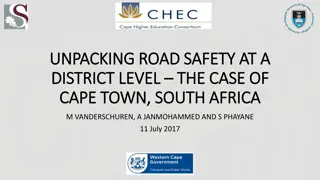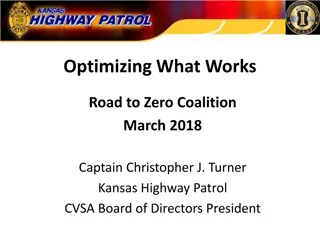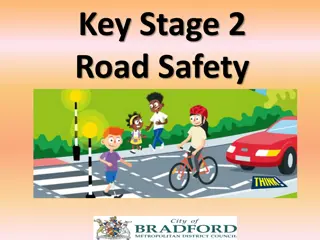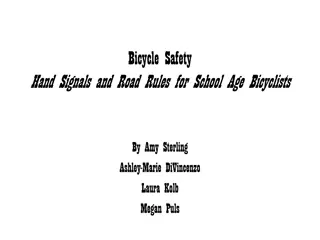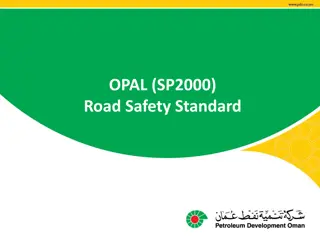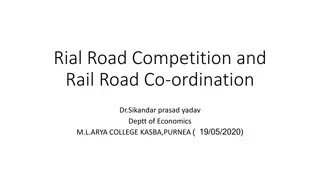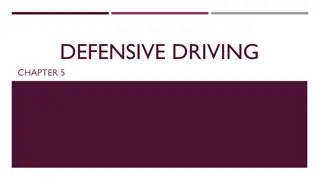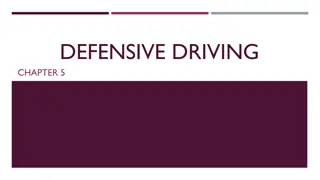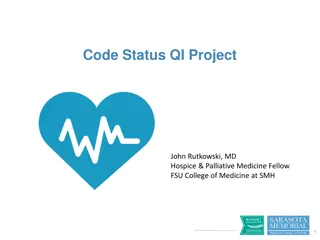WHO Global Status Report on Road Safety 2018: A Wake-Up Call
Road traffic injuries pose a significant global public health and development crisis, with an increasing number of fatalities annually. The WHO Global Status Report on Road Safety 2018 highlights the urgent need for action by Member States to address this pressing issue. Despite some improvements in high and middle-income countries, the overall number of road traffic crash fatalities has risen. The report serves as a crucial wake-up call to prioritize road safety initiatives worldwide.
Download Presentation

Please find below an Image/Link to download the presentation.
The content on the website is provided AS IS for your information and personal use only. It may not be sold, licensed, or shared on other websites without obtaining consent from the author. Download presentation by click this link. If you encounter any issues during the download, it is possible that the publisher has removed the file from their server.
E N D
Presentation Transcript
WHO GLOBAL STATUS REPORT ON ROAD SAFETY; 2018
INTRODUCTION: Road traffic injuries are a major but neglected global public health and development crisis, and are predicted to increase if road safety is not addressed adequately by Members States. The World Health Organization (WHO) has been concerned with this issue for decades .AS early as 1972,a WHO report discussed the nature and dynamics of the problem(1).In 1974, the World Health Assembly adopted Resolution WHA2759,declaring road traffic crash a major public health issue and calling for Member States to address the problem(2).
INTRODUCTION CONTD For the past decades too, the World Bank has encouraged its borrowers to include road safety components within most of their highway and urban transport projects. This joint WHO/World Bank effort and report on road traffic injury prevention 2004, is an important part of response to the World s road safety crisis where 1.20 Million deaths were recorded annually. It is directed at International, regional and national policy-makers, International agencies and key professional in public health, transport, engineering ,education and other sectors to stimulate action for road safety.
INTRODUCTION CONTD In this same vein however, WHO Global status report on road safety 2018, is also another serious and alarming wake up call for road safety to all the Member States, in view of worsening and threatening nature road traffic crashes worldwide.
AIM: The aim of this paper is to acquaint the course participants to be abreast of the recent WHO global on report Road Safety.
OBJECTIVES: At the end of this presentation, the participants should be able to: (a)Explain the recent WHO global status report on road safety 2018; (b) Be aware of the major aims of the global status report on road safety; (c)Also state as well the cardinal objectives of the report to the Member States.
WHO GLOBAL STATUS REPORT ON ROAD SAFETY 2018; A WAKE UP CALL FOR ROAD SAFETY: The WHO released the Global Status Report on Road Safety on December 2018.According to the report, relative to the World s population size, road death rates have remained fairly constant. Yet the overall number of people killed by road traffic crashes each year has increased to 1.35 million equivalent to one death every 24seconds.While some reductions in road deaths have been seen among high and middle income Countries, no low Country has reduced road deaths since the last report in 2015, which has 1.25 Million deaths annually and 1.24 Million deaths annually
WHO GLOBAL STATUS REPORT ON ROAD SAFETY 2018; A WAKE UP CALL FOR ROAD SAFETY CONT D in 2013. The risk of dying on the road is three times higher for those living in a low income Countries than in high income Countries. Lotte Brondum,Executive Director at the Global Alliance of NGOs for Road Safety(The Alliance) gave her reaction to report s findings:
WHO GLOBAL STATUS REPORT ON ROAD SAFETY 2018; A WAKE UP CALL FOR ROAD SAFETY CONT D Analysis of the Global Status Report on Road Safety 2018 is bleak: It shows a picture of inertia, where a massive public health crisis is happening right now in front of our eyes, and yet passively aside as people continue to die on the roads. This crisis is not just about the numbers, it is personal -1.35million-fathers, brothers, sons, and daughters preventable tragedies. governments stand mothers, sisters, through lost
WHO GLOBAL STATUS REPORT ON ROAD SAFETY 2018; A WAKE UP CALL FOR ROAD SAFETY CONT D The report shows starkly that the global commitments made by UN Member States to reduce road deaths and injuries by 50% by 2020 have not translated into necessary action .The burden continues to fall on the poorest nations and ,despite pockets of progress ,real change has not been seen .Road traffic injuries are now the eighth leading cause of death globally, up from ninth in 2015,and the number one killer of five-to-29-year-old.Road deaths exceed those of HIV/AIDS, tuberculosis, and diarrhoeal diseases, yet financial investment is a fraction of that invested in other diseases.
WHO GLOBAL STATUS REPORT ON ROAD SAFETY 2018; A WAKE UP CALL FOR ROAD SAFETY CONT D Real change can only happen if political will and financial commitment are activated if our decision makers are shocked into action. We must use this report as a wake up call. We call for government to commit themselves to policy change that puts road users, especially pedestrians and cyclists, at the center, stronger enforcement of traffic laws; funding that meets the severity of the road crisis; and the involvement of NGOs and collaborations that harness the unique expertise of different partners. other Stakeholders in
WHO GLOBAL STATUS REPORT ON ROAD SAFETY 2018; A WAKE UP CALL FOR ROAD SAFETY CONT D We call on NGIs around the world to raise their voices and the voices of their communities ,families ,and victims; to hold their government accountable for promise made and to cast a spotlight that cannot be ignored on these global and national statistics .We must use the report as the valuable tool that it is. We also call on all the Stakeholders, including government and NGOs, to look ahead: the Third Ministerial Conference on Road Safety will be held in Sweden in 2020, and the global goals will be scrutinized and renegotiated. It is essential that national government take part in and commit to this debate and that NGOs preparation .
WHAT ARE THE MAJOR GOALS WHO GLOBAL STATUS REPORT ON ROAD SAFETY SEEK TO ACHIEVE? Apart from the burden of road traffic injuries and the urgent need for government and other key players to increase and sustain action to prevent road traffic injury, the report primarily seeks to achieve the following; To create a great level of awareness, commitment and informed decision-making at all levels including among governments professional sectors and International agencies- so that strategies scientifically proven to be effective response to the global challenges are quickly implemented.
WHAT ARE THE MAJOR GOALS WHO GLOBAL STATUS REPORT ON ROAD SAFETY SEEK TO ACHIEVE CONT D? To provide a sound justification for the change in thinking that has taken place in recent years, especially where significant research has been undertaken, about the nature of the road traffic injury problem and what constitutes successfull prevention. Other goals of the report are: -To raise sensitization about the magnitude, risk factor and impact of road traffic collisions globally; -To draw attention to the preventability of the problem and present known intervention strategies. -To call for a coordinated approach across all sectors to address the problem.
CONCLUSION: The problem of road traffic crashes and injuries is growing both in absolute numbers and in relative terms. As motorization increase, many low-income and middle-income Countries may face a growing toll of road traffic injuries, with potentially devastating consequences in human, social and economic terms. Unless appropriate action is taken urgently or without new or improved interventions, the traffic injuries will be the third leading cause of death by the year 2020, globally.
